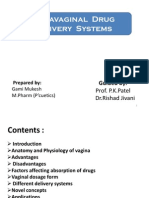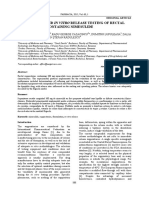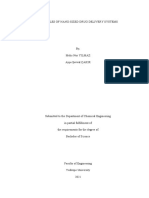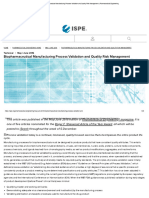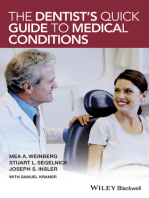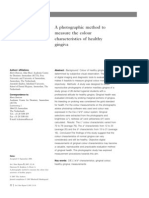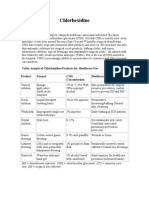0.2% Chlorhexidine
0.2% Chlorhexidine
Uploaded by
Krishan GuliaCopyright:
Available Formats
0.2% Chlorhexidine
0.2% Chlorhexidine
Uploaded by
Krishan GuliaOriginal Title
Copyright
Available Formats
Share this document
Did you find this document useful?
Is this content inappropriate?
Copyright:
Available Formats
0.2% Chlorhexidine
0.2% Chlorhexidine
Uploaded by
Krishan GuliaCopyright:
Available Formats
Volume 82 Number 1
0.2% Chlorhexidine Mouthwash With an Antidiscoloration System Versus 0.2% Chlorhexidine Mouthwash: A Prospective Clinical Comparative Study
Carols Sols,* Antonio Santos,* Jose Nart,* and Deborah Violant*
Background: The goal of this study is to evaluate the degree of staining and clinical efcacy of a chlorhexidine mouthwash with an antidiscoloration system (ADS) versus 0.2% chlorhexidine mouthwash (traditional). Secondary objectives are to evaluate the patient compliance factor according to patterns assigned by the clinician and to observe the side effects of the two mouthwashes. Methods: This comparative study is carried out on a sample of 15 non-smoking patients with chronic periodontitis at the Department of Periodontology, the International University of Catalunya, Barcelona, Spain. All patients used either 0.2% chlorhexidine mouthwash (control group = bottle B) or chlorhexidine with ADS (test group = bottle A) for 15 days. Each patient rst rinsed with a randomly assigned mouthwash for 15 days followed by a 15-day washout period. Subsequently, each patient used a second mouthwash. Before each cycle, a full dental prophylaxis was performed. The plaque, gingival, and Brecx staining indexes were used. Results: The results showed less tooth staining with the test group (P <0.01). No statistically signicant differences were observed in plaque (P = 0.1496) and gingival indexes (P = 0.1688). Eighty-eight percent of patients followed the instructions outlined in the protocol. In terms of other adverse effects, two patients reported a bad taste with both mouthwashes. Conclusions: The test group with ADS had less staining than the control group during a usage period of 15 days. However, the two mouthwashes seemed to be equally effective as antiplaque and antigingivitis agents. J Periodontol 2011;82: 80-85. KEY WORDS Chlorhexidine; chronic periodontitis; dental plaque; mouthwashes; oral hygiene; staining and labeling.
* Department of Periodontology, International University of Catalunya, Barcelona, Spain.
ental plaque is the primary etiologic factor of the two most prevalent oral diseases: dental caries and periodontal disease.1 Studies have clearly demonstrated that the ability to control the onset or progression of periodontal diseases is improved by regular plaque-control practices.2,3 Although data show that oral health can be improved through effective plaque control, mechanical means of cleaning are failing to deliver optimal levels of oral health because the techniques are not done consistently or thoroughly. Yet, these studies have also demonstrated that oral hygiene routines (daily toothbrushing and ossing) are neither practiced consistently nor are they done for an adequate amount of time to thoroughly remove plaque. These limitations on home oralcare practices suggest that other strategies are urgently required. As noted by De Paola et al.,4 mechanical oral hygiene methods of plaque removal require time, motivation, and manual dexterity. Therefore, chemotherapeutics agents can play a pivotal role as adjuncts of mechanical plaque-control methods. As others have suggested, the use of chemotherapeutic agents as adjuncts of mechanical at-home plaque control is recommended.5,6 In most cases, during phase I therapy, the clinician recommends the patient use an antimicrobial agent for reducing
doi: 10.1902/jop.2010.100289
80
J Periodontol January 2011
Sols, Santos, Nart, Violant
plaque and gingivitis, as an adjunctive therapy.7-9 These microbial agents include metal salts (tin uoride, zinc, or copper);10 essential oils;11 phenols (triclosan);12 uorides (sodium uoride or stannous uoride);13 bisbiguanides (chlorhexidine);14 quaternary ammonium compounds (chloride cetylpyridium);15 sanguinarine;16 and oxygenating agents17 among others.9,18 Clinical studies have shown that many of these antimicrobial agents have inhibitory effects on plaque and gingivitis compared to negative controls or placebos, in the absence of toothbrushing.9,18 However, when using these microbial agents in combination with toothbrushing, they do not all provide a signicant effect compared to a negative control in reduction of plaque and gingivitis.19 Chlorhexidine is considered the gold standard agent for its clinical efcacy in chemical plaque control.19-23 Chlorhexidine has broad antibacterial activity, with very low toxicity and strong afnity for epithelial tissue and mucous membranes.21 Besides its antiplaque effect, chlorhexidine is substantive, thus reducing levels of microorganisms in saliva up to 90% for several hours.19,21,24-26 The use of chlorhexidine is burdened by some side effects that could affect patient compliance.27 The most notable of these is the staining it produces.26,28 Other side effects associated with chlorhexidine include the alteration in taste and mucosal erosions,24,29 but these are less common. Studies have shown different methods to eradicate or minimize staining on enamel and cementum.26,30,31 These results show the effectiveness of a 0.2% chlorhexidine with antidiscoloration system (ADS) mouthwash compared to a 0.2% chlorhexidine mouthwash. The ADS system is composed of ascorbic acid and sodium metabilsulfate. This clinical study aimed to assess the degree of staining and clinical efcacy of a 0.2% chlorhexidine mouthwash with ADS compared to a 0.2% chlorhexidine mouthwash in patients with chronic periodontitis over a 15-day period. Other objectives of this clinical investigation were to determine patient compliance patterns assigned by the clinician, and the possible occurrence of other side effects, besides staining, after use of the mouthwash. MATERIALS AND METHODS Study Population A total of 17 patients (eight male and nine female, aged 35 to 69 years; mean age: 55.47 years) were initially included in the study. The mean number of teeth was 23.4 (third molars were excluded). Two patients were excluded because they did not follow the study protocol. The study was conducted at the Dental Clinic of the International University of Catalunya,
Barcelona, Spain, by the Department of Periodontology from March to June 2009. The Ethics Committee of the University previously accepted the study. All patients signed written informed consent. Study Design This is a comparative, crossover, double-masked study between a mouthwash that contains 0.2% chlorhexidine and a mouthwash containing 0.2% chlorhexidine with ADS. Patients were comprised of non-smokers with chronic periodontitis, 20 teeth, and without systemic diseases, such as uncontrolled diabetes, cardiovascular disease, and infectious diseases. Patients who were pregnant, nursing, or using antibiotics or antiinammatory drugs were also excluded. Chronic periodontitis is dened as a plaque-induced periodontal infection ongoing with gingival inammation, bleeding on probing from the gingival pocket area, reduced resistance of the periodontal tissues to probing (periodontal pocketing), clinical attachment loss, and alveolar bone loss.30 Each patient had a 15-day cycle using an undiluted 10-ml dose of a rst mouthwash for 1 minute, twice daily (morning and evening). The mouthwash samples for study were previously labeled, assigning the letters A (0.2% chlorhexidine mouthwash plus ADS) and B (0.2% chlorhexidine mouthwash). The delivery of each mouthwash to patients was done randomly with the help of a dental assistant (Rebeca Manso, International University of Catalunya) masked to the researchers. Before each mouthwash cycle, patients were instructed not to drink coffee, wine, or tea 1 hour before or after using the mouthwash; a full supragingival prophylaxis was performed; and intraoral photographs were taken. At 7 and 15 days the plaque index (PI),32,33 gingival index (GI),31,33 and Brecx staining index (BI)34,35 were recorded. The three indexes were evaluated on all the teeth in the patients mouth, excluding third molars. The GI and PI were evaluated in the four gingival units of the same teeth (mesial, distal, vestibular, and palatal/lingual), and the BI was assessed only in two gingival units (buccal and palatal/lingual). All patients remained 15 days without using any rinse (washout period). Then they performed the second 15-day cycle with a second mouthwash, after which the same clinical parameters were assessed at the end of this second cycle. The brushing technique used during the study corresponded to the modied Bass technique36 along with interdental brushing. Toothpaste without sodium lauryl sulfate and with 0.05% uoride to prevent interaction with chlorhexidine, a regular toothbrush, interdental toothbrush, and dental oss were
Curasept Curaden Healthcare, Curaden International AG, Kriens, Switzerland.
81
Chlorhexidine Mouthwash With ADS and Chronic Periodontitis
Volume 82 Number 1
given to each patient at the beginning of study. The questionnaire completed by the clinician (CS) at 7 and 15 days when using mouthwashes A and B took into account the PI, SI, BI, and general data (name, age, sex, race, and so forth). In addition, the survey included questions related to the side effects (taste modication or injury to oral mucosa) of the mouthwash in the mouth experienced by patients during the study. After each cycle patients brought a lled questionnaire showing their compliance and the two empty mouthwash bottles. A single masked researcher (CS) performed clinical assessments and data collection. The data collection period was approximately 1.5 months per patient. Data Analysis The results were evaluated with factorial analysis of variance. The primary outcome variable was patient pigmentation. Other variables tested were plaque reduction, gingival inammation, and other side effects (food taste, mucosal irritation, and so forth). All the variables were tested between the two different mouthwashes within the same patient and over time, between weeks 1 and 2. Also considered was the interaction between treatment and time, exploring potential differences in the effect of the mouthwashes at Days 7 and 15. The interaction between the mouthwashes tested and patients was also considered, but if it was insignicant it was deleted from the model. RESULTS Two patients were excluded because they did not correctly follow the sequence of use of the mouthwashes. A total of 15 patients (eight male and seven female) completed the study. All patients were treated with a full supragingival prophylaxis before each mouthwash cycle and were reevaluated at days 7 and 15 when using each mouthwash. No patients reported any complication or unexpected complaints. Figure 1 shows PI32 over time, either at 7 or 15 days (P = 0.6161). The means and standard deviations of the PI for mouthwash A (0.2% chlorhexidine plus ADS) at 7 and 15 days were 0.077 0.085 and 0.087 0.129, respectively. For mouthwash B (0.2% chlorhexidine) the means and standard deviations of the PI at 7 and 15 days were 0.135 0.278 and 0.175 0.267, respectively. The two mouthwashes (test and control group) were equally effective in reducing plaque in the patient. No statistically signicant differences were observed in plaque reduction (P = 0.1243) between the two mouthwashes. Regarding the GI,31 no statistically signicant difference (P = 0.2253) was found in the GI over time, either at 7 or 15 days. The two mouthwashes presented a similar effectiveness on gingival inamma82
Figure 1.
Mean PI in test group (0.2% chlorhexidine with ADS) (A) and control group (0.2% chlorhexidine) (B) at 7 and 15 days. Condence interval 95%; P = 0.1243.
tion, with no statistically signicant difference (P = 0.1688). The means and standard deviations of the GI for mouthwash A (0.2% chlorhexidine plus ADS) at 7 and 15 days were 0.061 0.069 and 0.082 0.085, respectively. The means and standard deviations of the GI for mouthwash B (0.2% chlorhexidine) at 7 and 15 days were 0.210 0.363 and 0.072 0.072, respectively (Fig. 2). Figure 3 shows that the more days the patients use each mouthwash, the greater the staining. With mouthwash B, BI35 is much higher than with mouthwash A (Fig. 4). The values obtained are statistically significant (P 0.05). The means and standard deviations of the BI for mouthwash A (0.2% chlorhexidine plus ADS) at 7 and 15 days were 0.205 0.194 and 0.521 0.337, respectively. The means and standard deviations of the BI for mouthwash B (0.2% chlorhexidine) at 7 and 15 days were 0.441 0.344 and 0.953 0.484, respectively (Figs. 4 and 5). As for any other side effects reported after the use of the mouthwashes, the results suggest no signicant difference between the two groups (P = 1.0000). DISCUSSION After analyzing the results obtained during our clinical study comparing 0.2% chlorhexidine mouthwash containing ADS to the standard 0.2% chlorhexidine, we observed that the mouthwash plus ADS has the same antiplaque and antigingivitis effects as the classic mouthwash with 0.2% chlorhexidine. Furthermore, a marked decrease in staining was observed with the test mouthwash. In terms of other adverse effects, we found two patients reporting bad taste that may have resulted from the use of these mouthwashes (mucosal injury, burning mouth, or bad taste when eating), conrming previous studies.22,26,27,30
J Periodontol January 2011
Sols, Santos, Nart, Violant
Figure 4. Figure 2.
Mean GI in the test group (0.2% chlorhexidine with ADS) (A) and the control group (0.2% chlorhexidine mouthwash) (B) at 7 and 15 days. Condence interval 95%; P = 0.1688. BI after using both mouthwashes: 0.2% chlorhexidine mouthwash with ADS (A) and a 0.2% chlorhexidine mouthwash (B). Condence interval 95%; P 0.05. SD for A and B: 0.363 0.314 and 0.697 0.488, respectively.
Figure 3.
BI at 7 and 15 days after the use of both mouthwashes. Condence interval 95%. SD at 7 and 15 days: 0.323 0.299 and 0.737 0.465, respectively.
Few studies have analyzed the staining produced after application of a mouthwash with ADS.22,26,27,30,35 In a study by Bernardi et al.,29 15 patients with oral health without gingivitis were given 0.2% ADS chlorhexidine mouthwash compared to a 0.2% chlorhexidine mouthwash for 15 consecutive days, with a 15-day intervening washout period between them. The authors evaluated the PI32 and GI,31 and assessed staining with a color measurement system (based on the visible light spectrophotometer principle). Bernardi et al.29 concluded that there was no signicant difference in relation to PI and GI between the two mouthwashes in healthy patients, but a statistically signicant difference was observed in the adverse effect of staining, demonstrating that the mouthwash with ADS prevented pigmentations. The authors29 recommended the need to conduct this study in patients with periodontitis or with recessions.
Our study, performed in patients with periodontitis and recessions, corroborates the ndings of Bernardi et al.29 Another paper by Basso et al., with a similar study design to Bernardi et al.,29 conrmed both their results and ours, showing less staining with a 0.2% chlorhexidine with ADS (unpublished data, 2006). Bellia et al. compared the 0.2% chlorhexidine mouthwash with ADS and 0.2% chlorhexidine toothpaste with ADS to the classic 0.2% chlorhexidine mouthwash and the 0.2% chlorhexidine toothpaste with ADS in 20 orthodontic patients who followed a nonsurgical periodontal therapy (unpublished data, 2006). This double-masked study showed that better results were achieved clinically and statistically in the control of plaque, gingival status, and staining in patients using the mouthwash with ADS (unpublished data, 2006). In contrast, the in vitro research conducted by Addy et al.19 claimed that they did not nd statistically signicant differences in terms of decreased staining with the ADS system incorporated in the 0.12% and the 0.2% chlorhexidine mouthwashes versus 0.2% chlorhexidine (positive control) and water (negative control). In addition, Arweiler et al.24 compared a 0.2% chlorhexidine mouthwash without alcohol to ADS versus 0.2% chlorhexidine mouthwash with 7% ethanoli to a placebo solution containing sorbitol, concentrated pepper, and alcohol at 14%, in 21 patients. They concluded that besides reducing staining, the ADS system also decreased the effectiveness of chlorhexidine on dental plaque, which contradicts the results of our study and those of others,22,26,27,30,35 which found that chlorhexidine is effective in decreasing dental
CIELab, ETS Laboratories, St. Helena, CA. Corsodyl, GlaxoSmithKline, Oral Healthcare, Weybridge, UK. i GlaxoSmithKline.
83
Chlorhexidine Mouthwash With ADS and Chronic Periodontitis
Volume 82 Number 1
CONCLUSIONS The ADS mouthwash produces less dental staining in patients with chronic periodontitis, and it is equally effective as an antiplaque and antigingivitis agent compared to 0.2% chlorhexidine mouthwash during a 15-day period of use. According to the questionnaire, 88% of patients followed the guidelines assigned by the clinician. The clinical manifestations and other possible adverse effects were minimal when using either mouthwash for a 15-day period. More controlled, randomized clinical studies with a larger sample size are needed. Figure 5.
Mean BI in the test group (0.2% chlorhexidine with ADS) (A) and the control group (0.2% chlorhexidine mouthwash) (B) at 7 and 15 days. Condence interval 95%; P 0.05.
plaque. This article24 assesses the effectiveness through bacteria that survived at 24 and 96 hours after using the mouthwash two times a day. The most recently published study37 using 0.2% chlorhexidine with ADS system compared it with a 0.2% chlorhexidine mouthwash for 1 week after periodontal surgery in 48 consecutive patients in treatment. The authors did not allow dental or interdental brushing over the area that underwent surgery. One week later, at suture removal, a full professional prophylaxis was performed and the second mouthwash was given with the same indications of use as the rst mouthwash. The results were consistent with those obtained in our study: less staining was observed when using the 0.2% chlorhexidine mouthwash with ADS and similar effectiveness between the two mouthwashes in reducing gingival inammation after surgery. The authors37 stressed that after the use of the 0.2% chlorhexidine with ADS there were fewer adverse effects and a more pleasant taste sensation compared to the classic mouthwash (0.2% chlorhexidine). In our study, we also observed less staining with the 0.2% chlorhexidine with ADS, but we did not observe any other differences in side effects between the two mouthwashes. The compliance factor has not been mentioned in previous comparative clinical studies reviewed. It is important to note that according to our questionnaire, 88% of patients followed the instructions outlined in the protocol. Some limitations have to be taken into account in our study. The sample is small, and the evaluation of the staining used is subjective. Other more objective methods, such as spectrophotometry, to measure staining are available, and the results might have been different.
84
ACKNOWLEDGMENTS The authors are grateful to Curaden International AG, Kriens, Switzerland, for providing the mouthwash, toothpaste, toothbrush, interdental toothbrush, and the dental oss for the study, and for their attention and availability provided throughout the research. The authors report no conicts of interest related to this study. REFERENCES
1. Page RC, Offenbacher S, Schroeder HE, Seymour GJ, Kornman KS. Advances in the pathogenesis of periodontitis: Summary of developments, clinical implications and future directions. Periodontol 2000 1997;14: 216-248. 2. Axelsson P, Lindhe J. Efcacy of mouthrinses in inhibiting dental plaque and gingivitis in man. J Clin Periodontol 1987;14:205-212. 3. Axelsson P, Nystrom B, Lindhe J. The long-term effect of a plaque control program on tooth mortality, caries and periodontal disease in adults. Results after 30 years of maintenance. J Clin Periodontol 2004;31:749-757. 4. DePaola LG, Overholser CD, Meiller TF, Minah GE, Niehaus C. Chemotherapeutic inhibition of supragingival dental plaque and gingivitis development. J Clin Periodontol 1989;16:311-315. 5. Bouwsma OJ. The status, future, and problems of oral antiseptics. Curr Opin Periodontol 1996;3:78-84. 6. Wolff LF. Chemotherapeutic agents in the prevention and treatment of periodontal disease. Northwest Dent 1985;64:15-24. 7. Nishihara T, Koseki T. Microbial etiology of periodontitis. Periodontol 2000 2004;36:14-26. 8. Addy M, Moran JM. Clinical indications for the use of chemical adjuncts to plaque control: Chlorhexidine formulations. Periodontol 2000 1997;15:52-54. 9. Ciancio SG. Chemical agents: Plaque control, calculus reduction and treatment of dentinal hypersensitivity. Periodontol 2000 1995;8:75-86. 10. Stephen KW, Burchell CK, Huntington E, Baker AG, Russell JI, Creanor SL. In vivo anticalculus effect of a dentifrice containing 0.5% zinc citrate trihydrate. Caries Res 1987;21:380-384. 11. Lusk SS, Bowers GM, Tow HD, Watson WJ, Moftt WC. Effects of an oral rinse on experimental gingivitis plaque formation, and formed plaque. J Am Soc Prev Dent 1974;4:31-33, passim. 12. Jenkins S, Addy M, Newcombe RJ. A dose-response study of triclosan mouthrinses on plaque regrowth. J Clin Periodontol 1993;20:609-612.
J Periodontol January 2011
Sols, Santos, Nart, Violant
13. Beiswanger BB, Doyle PM, Jackson RD, et al. The clinical effect of dentifrices containing stabilized stannous uoride on plaque formation and gingivitis A six-month study with ad libitum brushing. J Clin Dent 1995;6(Spec. No.):46-53. 14. Addy M. Chlorhexidine compared with other locally delivered antimicrobials. A short review. J Clin Periodontol 1986;13:957-964. 15. Wolff LF, Pihlstrom BL, Bakdash MB, Schaffer EM, Aeppli DM, Bandt CL. Four-year investigation of salt and peroxide regimen compared with conventional oral hygiene. J Am Dent Assoc 1989;118:67-72. 16. Wennstrom J, Lindhe J. Some effects of a sanguinarine-containing mouthrinse on developing plaque and gingivitis. J Clin Periodontol 1985;12:867-872. 17. Jones CM, Blinkhorn AS, White E. Hydrogen peroxide, the effect on plaque and gingivitis when used in an oral irrigator. Clin Prev Dent 1990;12:15-18. 18. Jackson RJ. Metal salts, essential oils and phenols Old or new? Periodontol 2000 1997;15:63-73. 19. Addy M, Sharif N, Moran J. A non-staining chlorhexidine mouthwash? Probably not: A study in vitro. Int J Dent Hyg 2005;3:59-63. 20. Segreto VA, Collins EM, Beiwanger BB, et al. A comparison of mouthwashes containing two concentrations of chlorhexidine. J Periodontal Res 1986;21:23-32. 21. Jones CG. Chlorhexidine: Is it still the gold standard? Periodontol 2000 1997;15:55-62. 22. Moran J, Addy M, Kohut B, Hovliaras CA, Newcombe RG. Efcacy of mouthwashs in inhibiting the development of supragingival plaque over a 4-day period of no oral hygiene. J Periodontol 1994;65: 904-907. 23. Ellingsen JE, Rlla G, Eriksen HM. Extrinsic dental stain caused by chlorhexidine and other denaturing agents. J Clin Periodontol 1982;9:317-322. 24. Arweiler NB, Boehnke N, Sculean A, Hellwig E, Auschill TM. Differences in efcacy of two commercial 0.2% chlorhexidine mouthrinse solutions: A 4-day plaque re-growth study. J Clin Periodontol 2006;33: 334-339. 25. Jenkins S, Addy M, Newcombe RG. Dose response of chlorhexidine against plaque and comparison with triclosan. J Clin Periodontol 1994;21:250-255. 26. Santos A. Evidence-based control of plaque and gingivitis. J Clin Periodontol 2003;30(Suppl. 5):1316.
27. Ciancio SG. Antiseptics and antibiotics as chemotherapeutic agents for periodontitis management. Compend Contin Educ Dent 2000;21:59-62, 64, 66 passim, quiz 78. 28. Eriksen HM, Nordb H, Kantanen H, Ellingsen JE. Chemical plaque control and extrinsic tooth discoloration. A review of possible mechanisms. J Clin Periodontol 1985;12:345-350. 29. Bernardi F, Pincelli MR, Carloni S, Gatto MR, Montebugnoli L. Chlorhexidine with an anti discoloration system. A comparative study. Int J Dent Hyg 2004;2:122-126. 30. Armitage GC. Development of a classication system for periodontal diseases and conditions. Ann Periodontol 1999;4:1-6. 31. Loe H, Silness J. Periodontal disease in pregnancy. I. Prevalence and severity. Acta Odontol Scand 1963; 21:533-551. 32. Silness J, Loe H. Periodontal disease in pregnancy. II. Correlation between oral hygiene and periodontal condition. Acta Odontol Scand 1964;22:121-135. 33. Loe H. The gingival index, the plaque index and the retention index systems. J Periodontol 1967;38:610-616. 34. Lang NP, Raber K. Use of oral irrigators as vehicle for the application of antimicrobial agents in chemical plaque control. J Clin Periodontol 1981;8:177-188. 35. Brecx M, Macdonald LL, Legary K, Cheang M, Forgay MG. Long-term effects of Meridol and chlorhexidine mouthrinses on plaque, gingivitis, staining, and bacterial vitality. J Dent Res 1993;72:1194-1197. 36. Bass CC. The optimum characteristics of toothbrushes for personal oral hygiene. Dent Items Interest 1948;70: 697-718. 37. Cortellini P, Labriola A, Zambelli R, Prato GP, Nieri M, Tonetti MS. Chlorhexidine with an anti discoloration system after periodontal ap surgery: A cross-over, randomized, triple-blind clinical trial. J Clin Periodontol 2008;35:614-620. Correspondence: Professor Antonio Santos, Department of Periodontology, International University of Catalunya, C/ Josep Trueta s/n, Sant Cugat del Valles 08195, Barcelona, Spain. Fax: 34-935042001; e-mail: santosalemany@ telefonica.net. Submitted May 12, 2010; accepted for publication July 1, 2010.
85
You might also like
- The Art and Science of Thread Lifting: Based on Pinch AnatomyFrom EverandThe Art and Science of Thread Lifting: Based on Pinch AnatomyNo ratings yet
- 3 Topical and Transdermal Drug Products-Product Quality TestsDocument9 pages3 Topical and Transdermal Drug Products-Product Quality TestssofianesedkaouiNo ratings yet
- Influence of Sex Hormones On The PeriodontiumDocument11 pagesInfluence of Sex Hormones On The PeriodontiumElena IancuNo ratings yet
- Biological Functions of Each of The Following Peptides: (2 PTS)Document3 pagesBiological Functions of Each of The Following Peptides: (2 PTS)Gio PosadasNo ratings yet
- Practical Dentistry For Veterinary NursesDocument10 pagesPractical Dentistry For Veterinary NursesLucy LulubinaNo ratings yet
- Root Cause AnalysisDocument7 pagesRoot Cause Analysisapi-3163522290% (1)
- Hyaluronic AcidDocument38 pagesHyaluronic AcidCharissa ArdhinaNo ratings yet
- ContentsDocument35 pagesContentsMukesh GamiNo ratings yet
- Final Antiseptics PowerpointDocument77 pagesFinal Antiseptics Powerpointalana_sushineNo ratings yet
- Drug Development PathwayDocument15 pagesDrug Development PathwayYogya sreeharshini MandaliNo ratings yet
- Excipient ToxicityDocument87 pagesExcipient ToxicityUpendra ReddyNo ratings yet
- Microbial Aspects in Cleaning ValidationDocument14 pagesMicrobial Aspects in Cleaning Validationroshd1000No ratings yet
- Nonylphenol EthoxylatesDocument25 pagesNonylphenol EthoxylatesJakin RookNo ratings yet
- Milk Exosomes Review Melnik & Schmitz 2019Document33 pagesMilk Exosomes Review Melnik & Schmitz 2019ESTHEFANE SILVANo ratings yet
- GUI - FINAL - Determining Whether To Submit An ANDA or A 505 (B) (2) Application - Published - May2019Document17 pagesGUI - FINAL - Determining Whether To Submit An ANDA or A 505 (B) (2) Application - Published - May2019Proschool HyderabadNo ratings yet
- Topical Corticosteroids in Plaque PsoriasisDocument5 pagesTopical Corticosteroids in Plaque PsoriasisAnggie Pradetya MaharaniNo ratings yet
- Drug Delivery Strategies For Management of WomenDocument19 pagesDrug Delivery Strategies For Management of WomenDEVYANI KADAMNo ratings yet
- ANDA Submission Content and Format PDFDocument32 pagesANDA Submission Content and Format PDFAjeet SinghNo ratings yet
- Ipi 526734Document37 pagesIpi 526734UmmuNo ratings yet
- Local Drug Delivery System in PeriodonticsDocument68 pagesLocal Drug Delivery System in Periodonticsdrswai1100% (1)
- Suppositories Lab HaniDocument10 pagesSuppositories Lab HaniMayson BaliNo ratings yet
- Production Troubleshooting of Molded: Solid/Semi-solid Dosage FormsDocument21 pagesProduction Troubleshooting of Molded: Solid/Semi-solid Dosage FormsmorsiNo ratings yet
- Dissolutiontechnologies - in Vitro Release Test MethodsDocument6 pagesDissolutiontechnologies - in Vitro Release Test MethodsAna KovačevićNo ratings yet
- Orange Book 40th Annual - 2 PDFDocument1,626 pagesOrange Book 40th Annual - 2 PDFdianNo ratings yet
- Role of Excipients in Moisture Sorption andDocument64 pagesRole of Excipients in Moisture Sorption andgeoaislaNo ratings yet
- In Vitro Release Kinetic ModelsDocument34 pagesIn Vitro Release Kinetic Modelsruqayya muhammedNo ratings yet
- Menopause JOGC-Jan 09Document52 pagesMenopause JOGC-Jan 09refNo ratings yet
- 2022 - Moisture and Oxygen Barrier Properties of Glass, PET and HDPE Bottles ForDocument9 pages2022 - Moisture and Oxygen Barrier Properties of Glass, PET and HDPE Bottles ForShao-Yu ChangNo ratings yet
- Guideline On Pharmaceutical Development of Medicines For Paediatric UseDocument23 pagesGuideline On Pharmaceutical Development of Medicines For Paediatric UseJanssen Cariaga ValdezNo ratings yet
- Epidemiology of Periodontal DiseasesDocument14 pagesEpidemiology of Periodontal DiseasesFrancisca DinamarcaNo ratings yet
- Topical Drug Bioavailability, Bioequivalent and PenetrationDocument11 pagesTopical Drug Bioavailability, Bioequivalent and PenetrationDung Ngo0% (2)
- Povidone Iodine - RevisitedDocument4 pagesPovidone Iodine - RevisitedPatrick153No ratings yet
- Guideline of Packaging ValidationDocument4 pagesGuideline of Packaging Validation박성민No ratings yet
- Literature Review OxytocinDocument7 pagesLiterature Review Oxytocinafmzuiqllaaabj100% (1)
- Transdermal Drug Delivery SystemDocument99 pagesTransdermal Drug Delivery SystemIshtiaq AhmedNo ratings yet
- Data Collection For Research Source Documents and The Case Report Form (CRF)Document14 pagesData Collection For Research Source Documents and The Case Report Form (CRF)sprfyllisNo ratings yet
- ChlorhexidineDocument11 pagesChlorhexidineJuan José SantosNo ratings yet
- SPC - Ma130 00201Document6 pagesSPC - Ma130 00201Cassia FistulaNo ratings yet
- Comparability Protocols For Human Drugs and Biologics Chemistry Manufacturing and Controls Information Guidance For IndustryDocument24 pagesComparability Protocols For Human Drugs and Biologics Chemistry Manufacturing and Controls Information Guidance For IndustryJanki Patel100% (1)
- 03 030744e PVP Iodine GradesDocument20 pages03 030744e PVP Iodine Gradesdipakrussia0% (1)
- Oxfordshire ADULT Antimicrobial Prescribing Guidelines For Primary CareDocument21 pagesOxfordshire ADULT Antimicrobial Prescribing Guidelines For Primary CareDan IonescuNo ratings yet
- Stability Considerations in Liquid Dosage Forms Extemporaneously ...Document29 pagesStability Considerations in Liquid Dosage Forms Extemporaneously ...herryapt100% (1)
- Formulation and in VITRO Release Testing of Rectal Suppositories Containing NimesulideDocument7 pagesFormulation and in VITRO Release Testing of Rectal Suppositories Containing Nimesulidepatchris36No ratings yet
- 1.oral Infectious DiseasesDocument68 pages1.oral Infectious DiseasesDrMohamed AssadawyNo ratings yet
- Hepa Filter Integrity TestDocument13 pagesHepa Filter Integrity TestApoloTrevinoNo ratings yet
- Drug Development and ApprovalDocument16 pagesDrug Development and Approvalpulkit asati100% (1)
- Vapor Transmission TestDocument12 pagesVapor Transmission TestJheann Del RioNo ratings yet
- Physicochemical Factors Under Preformulation Study: Contents:-I. Physical Characteristics A. Bulk CharacteristicDocument18 pagesPhysicochemical Factors Under Preformulation Study: Contents:-I. Physical Characteristics A. Bulk CharacteristicFIRDA TRYANANo ratings yet
- Cannabidiol (CBD)Document8 pagesCannabidiol (CBD)Isaias Sanches LopezNo ratings yet
- Control of Oral Biofilms: T F. F & T BDocument7 pagesControl of Oral Biofilms: T F. F & T BGina BNo ratings yet
- A Validated IVRT Method To Assess Topical CreamsDocument14 pagesA Validated IVRT Method To Assess Topical CreamsIhor ZinchenkoNo ratings yet
- Sterilization: Chapter 13 - Lesson 1Document4 pagesSterilization: Chapter 13 - Lesson 1Priyankamohanant SumaNo ratings yet
- Principles of Nano-Sized Drug Delivery SystemsDocument81 pagesPrinciples of Nano-Sized Drug Delivery SystemsMelis Nur YılmazNo ratings yet
- Biopharmaceutical Manufacturing Process Validation and Quality Risk Mana...Document25 pagesBiopharmaceutical Manufacturing Process Validation and Quality Risk Mana...fereshteNo ratings yet
- SFDADocument111 pagesSFDAMohamed HassanNo ratings yet
- FDA Interpretation of 505 (B) (2) NDADocument36 pagesFDA Interpretation of 505 (B) (2) NDAShilpa KotianNo ratings yet
- Petition Response Letter From FDA CDER To Insys Therapeutics, IncDocument12 pagesPetition Response Letter From FDA CDER To Insys Therapeutics, IncKyleJaegerNo ratings yet
- Prevalence of Periodontitis in The Indian PopulationDocument7 pagesPrevalence of Periodontitis in The Indian PopulationRohit ShahNo ratings yet
- Handbook of Polymers for Pharmaceutical Technologies, Bioactive and Compatible Synthetic / Hybrid PolymersFrom EverandHandbook of Polymers for Pharmaceutical Technologies, Bioactive and Compatible Synthetic / Hybrid PolymersNo ratings yet
- Protein Sequencing and Identification Using Tandem Mass SpectrometryFrom EverandProtein Sequencing and Identification Using Tandem Mass SpectrometryRating: 4 out of 5 stars4/5 (2)
- Navigating the FDA 510(k) Process: Mastering the FDA Approval Process, #5From EverandNavigating the FDA 510(k) Process: Mastering the FDA Approval Process, #5No ratings yet
- Gingival Abscess Case ReportDocument4 pagesGingival Abscess Case ReportKrishan GuliaNo ratings yet
- Gingivectomy SeminarDocument64 pagesGingivectomy SeminarKrishan GuliaNo ratings yet
- Laser LatestDocument18 pagesLaser LatestKrishan GuliaNo ratings yet
- Color of GingivaDocument6 pagesColor of GingivaKrishan GuliaNo ratings yet
- Essential Medicine List PDFDocument7 pagesEssential Medicine List PDFericusmanNo ratings yet
- Chlorhexidine GluconateDocument6 pagesChlorhexidine GluconateArief Septiawan TangahuNo ratings yet
- 2-9 ControlDocument57 pages2-9 ControlNguyen PhamNo ratings yet
- CTG 2022 Somvital enDocument88 pagesCTG 2022 Somvital enMaha EttobiNo ratings yet
- How Does Oracort WorkDocument4 pagesHow Does Oracort WorkAnonymous G8oZXHJrNo ratings yet
- Isi Kandungan MaogDocument33 pagesIsi Kandungan Maogshamsyul iqramNo ratings yet
- Lary SprayDocument7 pagesLary SprayMedley SinkhaiNo ratings yet
- G32 Study IJAMDocument9 pagesG32 Study IJAMlilingNo ratings yet
- Canine Pododermatitis - The Agony of The Feet - SLIDESDocument15 pagesCanine Pododermatitis - The Agony of The Feet - SLIDESAdelina Daniela MunteanuNo ratings yet
- GST 311 AssignmentDocument9 pagesGST 311 AssignmentAyooluwa AkinmusireNo ratings yet
- Efficacy of Different Concentrations of Chlorhexidine Mouthwash On Plaque Accumulation and Periodontal ParametersDocument50 pagesEfficacy of Different Concentrations of Chlorhexidine Mouthwash On Plaque Accumulation and Periodontal ParametersrupaliNo ratings yet
- Marketing Management AssignmentDocument5 pagesMarketing Management AssignmentAisha RehmanNo ratings yet
- Dettol and IzalDocument30 pagesDettol and IzalDaniels DenenNo ratings yet
- Endodontic Materials: R. Scott Gatewood, DMDDocument18 pagesEndodontic Materials: R. Scott Gatewood, DMDcarlosNo ratings yet
- Bovine Surgery and Lameness (Second Edition)Document288 pagesBovine Surgery and Lameness (Second Edition)Frontline0712100% (2)
- Periodontology SHEETDocument10 pagesPeriodontology SHEETNada R. AbukhalafNo ratings yet
- Analytical Methods For The Determination of ChlorohexidineDocument14 pagesAnalytical Methods For The Determination of ChlorohexidineSanthi KumarNo ratings yet
- Product CatalogDocument44 pagesProduct CatalogKarita HarrskogNo ratings yet
- Endodontic DisesaeDocument9 pagesEndodontic DisesaeNouman NoorNo ratings yet
- By: Bettina Basrani, DDS, PHD: Text SizeDocument6 pagesBy: Bettina Basrani, DDS, PHD: Text SizeSilviu3103No ratings yet
- Queen Mary HospitalDocument16 pagesQueen Mary HospitalssyluisNo ratings yet
- The Effect of Delmopinol Mouthwash On Aphthous StomatitisDocument19 pagesThe Effect of Delmopinol Mouthwash On Aphthous StomatitisAthenaeum Scientific PublishersNo ratings yet
- Klompas PrevençPneumoniaUTI Rev SeminRespCritCareMed2019 PDFDocument10 pagesKlompas PrevençPneumoniaUTI Rev SeminRespCritCareMed2019 PDFLauren AlmeidaNo ratings yet
- Drugs and Medications - Oral Aid LotionDocument1 pageDrugs and Medications - Oral Aid LotionMey KhNo ratings yet
- ChlorhexidineDocument11 pagesChlorhexidineDienNguyen100% (1)
- PR2 Chapter 1 and 2 Final Group1Document12 pagesPR2 Chapter 1 and 2 Final Group1Dexter SolimanNo ratings yet
- List GalenicalDocument8 pagesList GalenicalmuhamadamiraluwiNo ratings yet
- Root Canal IrrigantsDocument10 pagesRoot Canal IrrigantsAumir BégNo ratings yet







